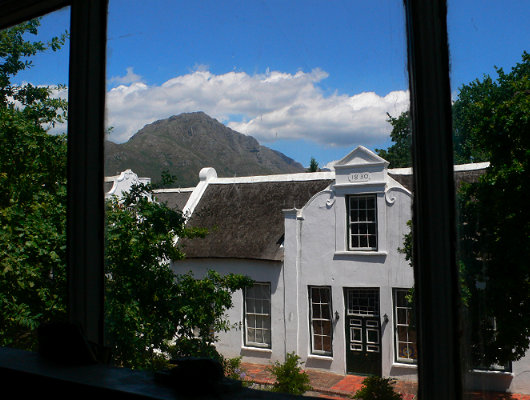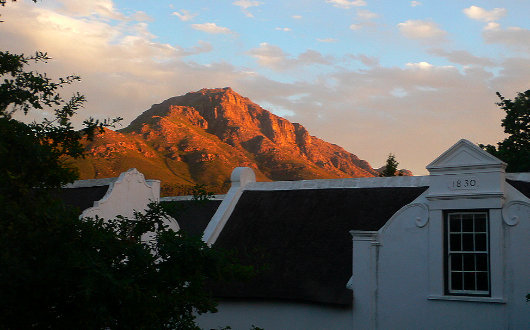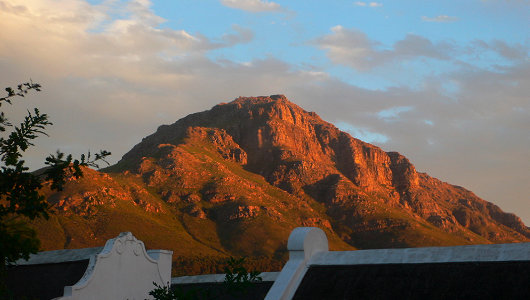Stellenbosch
About Andrew Cusack
 Writer, web designer, etc.; born in New York; educated in Argentina, Scotland, and South Africa; now based in London.
Writer, web designer, etc.; born in New York; educated in Argentina, Scotland, and South Africa; now based in London. read more
News
Blogs
Reviews & Periodicals
Arts & Design
World
France
Mitteleuropa
Knickerbockers
Argentina
The Levant
Africa
Cape of Good Hope
Netherlands
Scandinavia
Québec
India
Muscovy
Germany
Academica
Die Wapenskild van die Universiteit

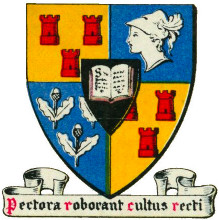 EDUCATION IN STELLENBOSCH began as early as 1685, but it wasn’t until 1866 that the Stellenbosch Gimnasium was founded. Like the (English-language) South African College in Cape Town, the Dutch/Afrikaans Gimnasium was a school covering secondary, and tertiary education. Twenty years after the foundation of the Gimnasium, it was renamed the Victoria Kollege in honour of the Queen’s jubilee of 1887. In 1918, the Parliament of South Africa finally reorganised education in the Cape, and separated both the South African College and the Victoria Kollege into their respective secondary and tertiary parts. SAC was divided into the University of Cape Town & the South African College Schools, while the Victoria Kollege was divided into the University of Stellenbosch & the Paul Roos Gymnasium.
EDUCATION IN STELLENBOSCH began as early as 1685, but it wasn’t until 1866 that the Stellenbosch Gimnasium was founded. Like the (English-language) South African College in Cape Town, the Dutch/Afrikaans Gimnasium was a school covering secondary, and tertiary education. Twenty years after the foundation of the Gimnasium, it was renamed the Victoria Kollege in honour of the Queen’s jubilee of 1887. In 1918, the Parliament of South Africa finally reorganised education in the Cape, and separated both the South African College and the Victoria Kollege into their respective secondary and tertiary parts. SAC was divided into the University of Cape Town & the South African College Schools, while the Victoria Kollege was divided into the University of Stellenbosch & the Paul Roos Gymnasium.
Along with gaining proper status as a university, the Universiteit van Stellenbosch also adopted a coat of arms in 1918. In the language of heraldry, the University’s coat of arms (or wapenskild in Afrikaans) is described as:
The “three towers gules” come from the arms of the town of Stellenbosch, and find their origin in the personal arms of Governor Simon van der Stel who founded the town in 1679. The quartering of yellow and blue (“or” and “azure”) was also inspired by van der Stel’s arms. Minerva symbolizes learning obviously, while the oak twigs represent the magnificent oak trees planted by Governor van der Stel, many of which still grace the streets of the town. The motto, Pectora roborant cultus recti, is Latin for “A sound education strengthens the spirit/character”.
Regrettably, the university tends to use its corporate logo of a stylised ‘S’ and oak leaf instead of its splendid heraldic achievement. The arms of the university can nonetheless be found around the town, displayed architecturally on numerous university buildings, in official university publications, on student clothing, and of course on the university tie.
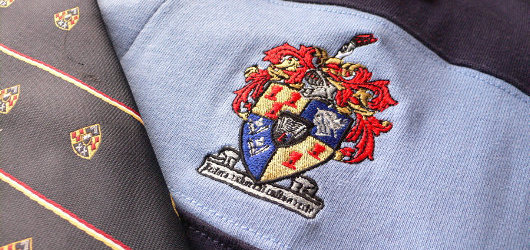
My bolt-hole in the Cape
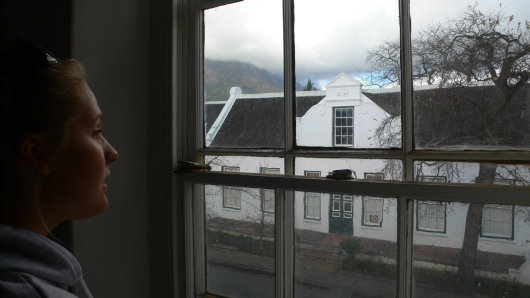
Winter in the Western Cape is relatively mild: grey days of pouring rain when the clouds veil Stellenbosch mountain, coupled with beautiful sunny afternoons best spent having a coffee with a friend at a sidewalk cafe.
Today is one of the grey days, however, in which one hopes to leave the house as little as possible (provided, that is, one is already adequately supplied with enough tea and books to last the day).
My little flat is in an old Dutch townhouse in the middle of town, one which the arbitrary modernisers neglected to supply with an alternative source of heat when they foolishly removed the iron stoves and blocked all the fireplaces.
Nevermind. A good jumper and a cup of rooibos will keep me warm as I make progress with Sassoon’s Memoirs. (more…)
« Kampusquote »
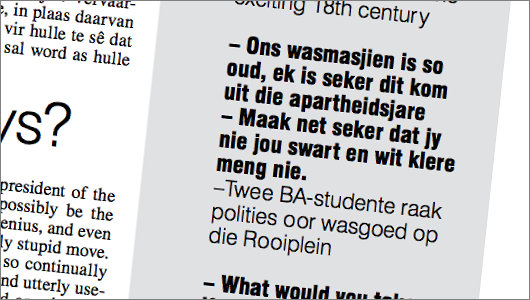
Many college newspapers have their “overheard” sections, in which they give a selection of amusing or stupid things said around town. Our paper, Die Matie, has “Kampusquote”, the latest installment of which featured this nugget:
“Just make sure you don’t mix your white and black clothes!”
Alright, it sounds better in Afrikaans. Another favourite of mine was:
— Student upon learning that the head of the Music Conservatory is rotated amongst the conservatory’s departmental chairs
Separation Anxiety
Fond of beer in swarthy nooks,
but happiest among his books.
Change happens very quickly these days, and it has always interested me that people born in the same year as me are (more or less) the youngest ones to remember life without the Internet. The younger siblings of friends have no experience, in particular, of being computer literate while not having the Internet. We, on the other hand, recall the tiny Macintosh “Classic” as well as the older machines with the green type on a black background from computer class in school. Computers were for typing things up, or else for games, and computer games were never of much interest in our household. Who could be bothered sitting in front of a monitor when you could have a waterfight with the neighboring kids? (The exception, for me, was SimCity 2000, in which you could be Robert Moses, Albert Speer, and a disastrous hurricane rolled into one.)
Then, of course, came the wonderful World Wide Web. You could send emails, though for the life of me I can’t remember sending any in the first years of our family getting Internet access. When first introduced to yahoo.com, I instantly dismissed it, for I was convinced that nothing of any import could be known by the name of “Yahoo.” Still, we kids couldn’t get enough of the Internet. I was primarily a news & history junkie, seeking to learn of events in far-off lands that I had spent hours discovering in encyclopediae and while pouring over giant maps laid out on the dining-room table or the living-room floor. Every National Geographic that arrived having the red text in the yellow margin that indicated a map was enclosed was received like a gift from the heavens and added to my collection—which included the Canadian provinces, the Soviet Union, Indonesia, the British Isles (when still called so), and of course the precious World Map. Most memorable was when, just a short while after the fall of the Iron Curtain, National Geographic released a map of “The New Europe” with a dozen new countries added and borders changed.
While books were essential during our childhood, the Internet, however, remained a mere sideshow, a curious novelty for occasional use. Then—gradually, sometime, somehow—it became an indispensable part of existence. Essays at school were completed with the help of Internet research, the great quest to decide where to go to college would have been impossible without all those .edu & .ac.uk websites wooing prospective undergraduates, and then the year I started university was marked by the advent of something called Wikipedia.
I found, contrary to the expectations of some, that the Internet did not compete with my love of books, but rather complemented it. One could “google” second-hand bookshops in New York, London, and Edinburgh and then pay them a visit. There, ancient tomes and beautiful editions could be found and, judiciously, purchased. And while reading those tomes, various ideas and inspirations would spring to mind which would cause one to place down the book to the left and turn to the laptop on the right and find out more about any given subject. If Paddy Leigh Fermour mentions a castle in Bohemia or Hungary, you have but to type out the correct spelling, click a button, and reams of up-to-date information about it are at your fingertips. And of course there is purchasing old books online, and thereby expanding one’s library: a particular joy.
But during my university years, spent between home in New York and uni in Scotland, my library was rent in twain. The age of manservants and transatlantic ocean liners having passed, I could not bring my entire collection of books wherever I went, but frequent travel between the two homes of my collection lessened the impact of not having “that” book immediately at hand.
The problem now is that I find myself in South Africa, separated from both my precious library (now consolidated in New York) and the Internet. This part of the world is a strange mix between Palo Alto and Lubumbashi, and the level of Internet connectivity is very poor. Here in Stellenbosch, luxurious vineyards dot the landscape, and lazy cafés sit under the shade of the oak-lined streets, but most Internet service providers charge for use by megabyte downloaded. To those of us accustomed to the easy broadband access of most of the northern hemisphere, it is the galling equivalent of being handed a reed and a wet clay tablet and being asked to send an email in cuneiform (or “stuur ‘n e-pos in spykersrif” as it would be in Afrikaans). I am ostensibly a student here, but even our university—which sent the first African satellite into space—charges its students for the Internet per megabyte used. I looked into getting the Internet installed at home—a flat in an old whitewashed Dutch house in the middle of town—but the widely recommended snowball.co.za is prohibitively expensive for a poverty-stricken young amateur scholar such as yours truly.
Luckily there is a little café just around the corner that only charges R17 for an hour’s wireless Internet, no megabyte limit, peer-to-peer software and mass media downloading prohibited (fair enough). Cheap as chips, but then only during their working hours, and completely ill-suited to my Internet-browsing sentiment. Gone the quick check-of-the-email at the very dawn of day. Gone the ability to google some ancient German dynasty that surfaced amidst a late night’s readings. Needless to say andrewcusack.com—my Internet repository of miscellaneous and somewhat unrelated information—has fallen by the wayside as well. I can purchase an hour’s cheap Internet, but an hour is not what I want. A rushed feeling pervades an hour’s purchased Internet. I want five minutes here, ten minutes there, two minutes elsewhere, and every now and then an hour or two for some knee-deep research.
So should any ambitious techies of Silicon Valley be readers of Taki’s Magazine, set your sights on South Africa. There is a fortune to be made if someone can make good Internet as cheap and accessible as back in the States, but be warned: it might take a good deal more cunning to get things done on African time.
[First published in Taki’s Magazine]
Search
Instagram: @andcusack
Click here for my Instagram photos.Most Recent Posts
- Faithful Shepherd of the Falklands April 8, 2025
- Articles of Note: 8 April 2025 April 8, 2025
- Proportionality Destroys Representation April 8, 2025
- Sag Harbor Cinema March 26, 2025
- Teutonic Takeover March 10, 2025
Most Recent Comments
Book Wishlist
Monthly Archives
Categories

